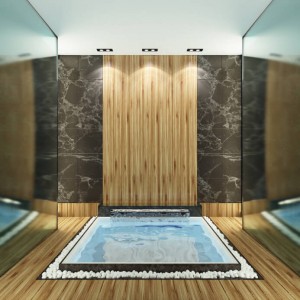Yes, there are actually quite a few similarities between a restaurant’s and a spa menu: you’ll get information about the offers and prices, some times about the philosophy or the approach of the place. You may even get information about the folks in the kitchen, take away offers, catering services (of course I’m still talking about restaurants J) etc. Now, but what is your impression if a restaurant offers a wild mix of, lets say Japanese Sushi, Indian Cuisine, some variety of Italian Spaghetti, a wide choice of Hamburgers and Bavarian Style breakfast? I would at least raise my eyebrows and probably walk away looking out for the next place…
Wellness
A spa can be simply perfect, designed by the best architects, furnished with the most elegant materials and filled with the most refined fragrances and music – in the end it’s the people in a spa that make the difference. This is why these “inner values” also belong to the personality of a spa. These values are created by the people in the spa and fill it with life. This includes employees and guests.
In one of our previous articles we already discussed ancient civilizations and their healing techniques. The practice of using massages as a curative method goes back to ancient history and is still highly evolving and performing in recent days. There are dozens of different massage techniques varied by cultures and stroking movements but they all share some beneficial effects. Read more
„The architect deals the cards.“ Many other things can subsequently be altered but hardly a building’s architecture. It defines the frame, within which the atmosphere develops. The architecture always follows a strategic concept. However, it can also be an essential part of that strategy, for example if the architecture is about achieving a unique position.
The spa architecture does not only serve optical purposes. It should also contribute to its profitability. This includes both the accents that it sets and the spatial division that strongly influences the processes in the spa. Read more
It’s the world’s biggest tourism trade fair taking place in Berlin every year. And yes – it is a must-go for all those active in the travel and tourisms business. Last week it was 50th anniversary of ITB and the fair hit another record in terms of visitors. Some 120.000 trade visitors came within three days to talk business, to network and to discover new trends and ideas. And – of course – we were amongst them. For me it’s really exciting to see what our industry – the medical spa, spa & wellness business – considers state of the art, what sells well in wellness, and what’s going to shape the next 12 months. Let’s have a look at the Wellness Trends at ITB 2016. Read more
Here it is: the secret formula for the perfect marketing for spas. Well, no, not really ;) … Of course there is no such thing or at least I personally do not believe in a one-size-fits-all formula when it comes to marketing & marketing communications. But I do believe that it is worth to set up smart checklists, or algorithms if you will, that help set up good marketing concepts for Spas. Read more
Spa Design is more than beauty, shapes, structures and comfortable cushions. It is about creating an environment and atmosphere that underpin the business in every respect and evoke an emotional response of your customers. A spa, assuming that it fulfils its function, has the ability to promote general relaxation and well-being.
Do you remember Kermit the frog singing, “it’s not easy to be green”? Same is true for communicating quality: it’s not easy to talk about quality. There are several reasons for this… Read more
The term „natural local remedies“ stands for an important future trend in health tourism. The “Zukunftsinstitut” considers the focus on health topics one of the mega trends: “Health no longer is the opposite of sickness but an awareness of the balance of the individual life energy. Thus, medicine has transformed from a specialized repair shop into a huge sector for the health “prosumer”. Read more
„The part can never be well unless the whole is well.” – Plato
It is self-evident that as long as life exists on Earth, mankind will have issues with curing and preventing diseases, in other words ‘maintaining health’. Unfortunately, our existing health-care practice is based upon a so-called allopathic medicine, which treats and suppresses only the symptoms of the human body. Read more










